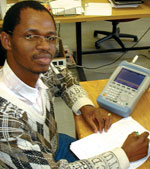
A post-graduate student at the University of Stellenbosch represented South Africa at the Utah Small Satellite Conference that was held in the USA in August.
Kgabo Mathapo presented a paper on South Africa's second satellite, recently named 'Sumbandila' - a Venda word that means 'showing the way' or 'Pathfinder'. Mathapo's paper deals with the software defined radio automatic identification receiver (AIS), one of the several experimental payloads on the satellite.

The satellite is being built by SunSpace, a company that has its origins from the Sunsat satellite programme of the University. Sunsat was developed completely by a local team of engineers and launched in 1999 by NASA. This team forms the core of SunSpace today.
The Small Satellite Conference's theme this year was: The first 20 years, where we have been - where we are going. Sunspace considered it important for South Africa to be presenting a paper and supported Mathapo's participation.
Software defined radio (SDR) is a technology that is currently being researched at the University of Stellenbosch because of its potential to realise reconfigurable radio systems and networks that use the same hardware for different applications. The primary purpose of the SDR AIS experimental payload on Sumbandila is to demonstrate the monitoring of marine traffic along the SA coast. The secondary purpose is to carry out scientific experiments that will demonstrate the possibility of reconfiguring radio systems on a satellite through software updates and to serve as proof of concept of SDR for satellite communication systems.
Sumbandila (ZA002) is South Africa's second satellite that will be launched in a low earth orbit and has in addition to experimental payloads, an on-board multisensor imager will be used to take high resolution images of the earth. The satellite will be launched into a 500 km sun-synchronous orbit with a local time (at the equator) of 10 am and 10 pm.
The SDR project will use a space-qualified VHF/UHF transponder and on-board processing unit, developed for small satellites by SunSpace. The SDR architecture itself allows for the development of a library of components that are used to build a radio system.
Mathapo is studying in the Department of Signal Processing and Telecommunications Research Group and is working on the SDR project as his thesis for his Masters Degree in Electronic Engineering which he expects to complete this year. His paper goes into detail about GMSK modulation, demodulation and filtering techniques.

© Technews Publishing (Pty) Ltd | All Rights Reserved